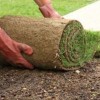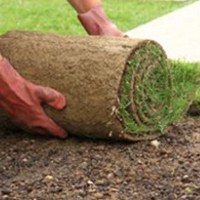new lawns

Keep Your Lawn Healthy
 Tips to Help Keep Your Lawn Healthy
Tips to Help Keep Your Lawn Healthy
Do you have a new lawn? If so, then you should know the keys to maintaining the health of your grass.
New lawn care involves three main components: water, mowing and traffic.
Water
New lawns should be watered daily during their first few weeks. This is crucial in new lawn care. Daily watering will help the roots to get established. Keep the turf very moist. If you are experiencing a drought in your area, or if you live in a very hot climate, you may need to water your new lawn twice a day.
While the key to new lawn care requires keeping the turf moist, you should not over water your new lawn to the point where it is a wet, muddy mess. Try to not saturate the soil. If puddles are forming in your lawn, you are watering too much. Too much water in the soil can keep the roots of your new grass from achieving deep roots.
If your grass starts to take on a gray color, it is telling you that it is not getting the water it needs. A quick way to see if your lawn is getting enough water is to use a knife or screwdriver to dig into the soil. The dirt should be damp to a depth of six inches.
Once your new lawn has passed the two week time period, you can reduce watering to two or three times per week. How often you water your new lawn at this stage will depend upon your environment. A new lawn in a dry climate or in an area that is experiencing significant drought may need to be watered four or five times per week.
Mowing
New lawn care guidelines for sod state that a first mowing can occur within three weeks of planting.New lawn care guidelines for seeded lawns state that it may be eight weeks before a mowing is needed.
Another key component to maintaining the health of your new lawn is to never mow your grass unless it is dry. Mowing on new, wet grass can pull the newly rooted grass out of the soil.
Never scalp your new lawn grass. It is better for your new lawn grass to be a little high than to be too short. By allowing your new lawn grass to grow a little high before cutting it will ensure that the grass is well rooted and established before it undergoes the trauma of a lawn mower blade.
Traffic
You should try to limit the amount of traffic on your new lawn during the first few weeks after planting. While it is unnecessary to keep all traffic off of your new lawn, traffic should be kept to a minimum. You will not want your children riding bikes or playing ball on your new lawn grass.
A lawn that is not protected from high traffic can be damaged and die. Friction on the new grass can pull up newly established roots that are still weak. Reducing friction is important in new lawn care.

Caring for New Sod Lawns
 How to Take Care of New Sod Lawns
How to Take Care of New Sod Lawns
So you live in Surrey, and just installed a new sod lawn. It needs good care. Sod is living and breathing and it can die. You should never schedule a delivery of sod until you are ready to install it. Sod should never be stored for more than a couple of days, or all you will have is a bunch of dirt and dead grass!
When you go to purchase sod, you should make sure it is freshly cut. You should also look for sod that has been grown on soil that is similar to the soil in your yard. When you install your sod, try to avoid stretching it or leaving any gaps between them. This will encourage weeds to grow.
You should know that heat can build up inside a roll of sod. As soon as it has been laid, you should take care of new sod lawns by giving them a good drink of water. Allow the water to penetrate to a depth of six inches.
During the first two weeks, you should take care of new sod lawns as if they are dehydrating. You cannot over water them. You can water your new sod lawn up to five times a day. The key is keeping the sod moist so the roots have time to take root. You should keep people and pets off of your new sod lawn if possible until it has had its first mowing. Most sod lawns can be mowed approximately two weeks after installation. However, if your lawn was installed in the cold months, it may be a while before a mowing is required. Keep in mind that it is better to mow high than to scalp your new lawn.
During the third and fourth weeks, you can start to reduce the frequency of waterings. While you may decrease the frequency of your waterings, you may want to increase how long you water. Sod lawns at this age really like deeper and less frequent waterings because it helps their roots to grow deeper to reach water. This establishes your new lawn into the soil and makes it stronger. If you want to check to see if your lawn is getting firmly rooted, simply tug on the turf. At the four week mark, you should apply an application of fertilizer to your new lawn.
Troubleshooting for New Sod Lawns – Solving Problems
If you think that your sod is not taking root fast enough, you should know that sod lawns that are planted in excessive shade will have a slow time at putting down roots than sod lawns which are in full sun. Adjusting your watering schedule can help a lawn that is having problems establishing roots. Doing less frequent but deeper soakings may help.
If your sod is shrinking, that’s a sign that it is not receiving enough water. Immediately begin increasing the duration and frequency of the waterings and the gaps should fill in.
Does your sod have bluish-grey spots? If so, these are drought spots. Take care of new sod lawns by increasing the minutes that you are watering. If you are using a sprinkler to water, make sure it is reaching the areas that are spotting.
